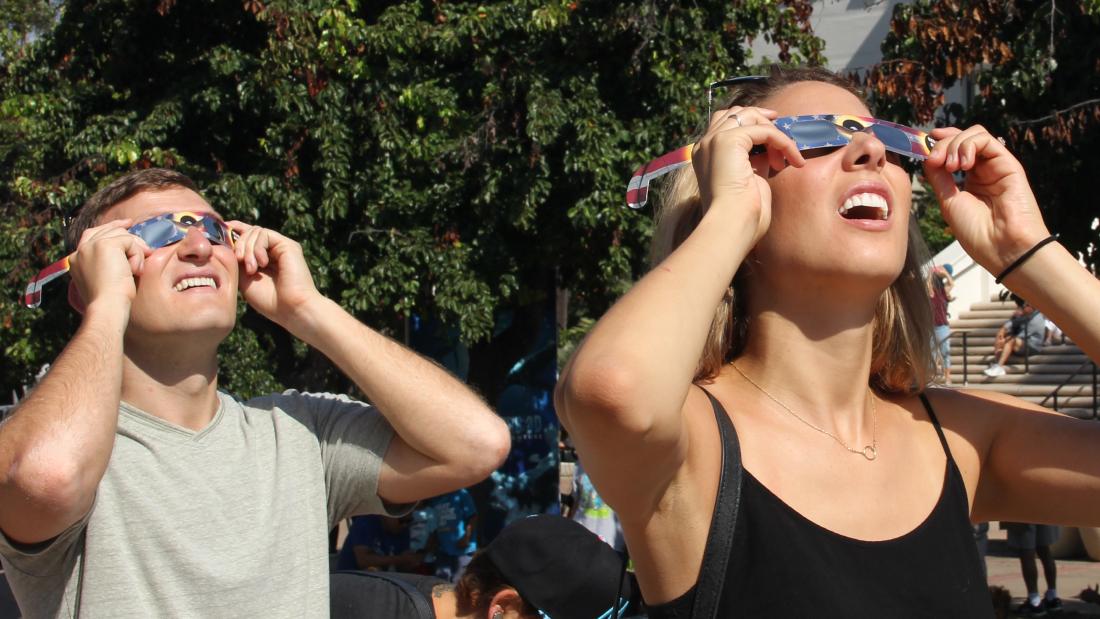
The Fleet Science Center will be closed on Thursday, November 28.
SAN DIEGO—On Saturday, October 14, a solar eclipse will be visible in San Diego, and the Fleet Science Center is hosting a viewing party, outside the Fleet, in front of the iconic Bea Evenson Fountain.
The event is free and begins at 8 a.m.
An annular solar eclipse occurs when the Moon passes between the Sun and Earth while the Moon is at its farthest point from the Earth, according to NASA. The result is that the Moon appears smaller than the Sun and does not completely cover it, creating a spectacular “ring of fire effect.” San Diegans’ experience will be a partial eclipse.
The eclipse will begin at 8:09 a.m. as the Moon appears to touch the Sun’s edge. The climax, when the Moon is closest to the center of the Sun, will be visible from San Diego at 9:26 a.m. Viewers will see the most exciting moments between 8:45 and 9:45 a.m., with the eclipse concluding at 10:52 a.m., as the Moon leaves the Sun’s edge.
The Fleet’s resident astronomer, Lisa Will, Ph.D., along with additional local astronomy and eclipse experts, will be on hand to answer questions and converse.
Three hands-on demonstration stations will feature activities, including crafting solar viewers, led by Fleet education professionals.
In addition, the Fleet will connect everyone to the power of science earlier than its usual 10 a.m. open time.
Craveology Café and the North Star Science Store will open at 8 a.m. so eclipse viewers can enjoy coffee and breakfast and shop for safe-viewing eclipse glasses and other eclipse-themed merchandise.
The Fleet galleries will open an hour early at 9 a.m. and will feature special eclipse programming
More than 5000 people attended the Great American Eclipse viewing party at the Fleet in 2017 when San Diego experienced 57% of a total solar eclipse.
Please note: Special equipment is needed to observe the eclipse. IT IS NOT SAFE TO LOOK DIRECTLY AT THE SUN DURING A PARTIAL SOLAR ECLIPSE! Looking directly at the eclipse can cause permanent eye damage. Telescopes and binoculars can be used to project images of the Sun on a flat surface, much like a pinhole camera.
Special Eclipse Shade glasses are available to purchase from the Fleet’s North Star Science Store. If you wish to observe through a telescope, you need a solar filter and cannot use your typical spotting scope to align.
For Media
To attend this special eclipse viewing party, schedule an interview with a Fleet subject matter expert or to learn more, please contact Fleet Science Center Communications Specialist Suzanne Sanders at (619) 238-1233 ext. 804 or ssanders@rhfleet.org.
Información y entrevistas en español también están disponibles para los medios necesarios.
Additional Information
About the Fleet Science Center
Since 1973, the Fleet Science Center has been a central link between science, schools and scientific organizations, collaborating with the communities that call San Diego County home. Its mission is simple yet bold: to realize a San Diego where everyone is connected to the power of science. The organization delivers on this mission through engaging experiences and culturally driven education programs in neighborhoods throughout the county and the historic Balboa Park flagship location. The Fleet creates places of inspiration by collaborating with communities to support and grow STEM talent in San Diego. From interactive exhibits and school field trips to free science programs, the Fleet is forward-thinking and consistently evolving to create positive change in the world. To learn more, visit fleetscience.org.
About Balboa Park
Located near downtown San Diego, Balboa Park is the largest urban-cultural park in the United States. First established by the City of San Diego in 1868, it is also one of the oldest city parks in the nation and is the most visited single destination in San Diego. Its 1,200 acres include 17 museums, many gardens and attractions, the San Diego Zoo, miles of hiking trails, and multiple athletic complexes to explore and discover. For more information, visit balboapark.org.